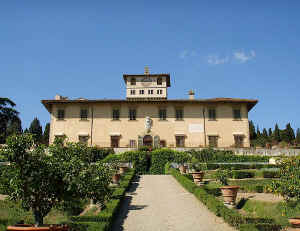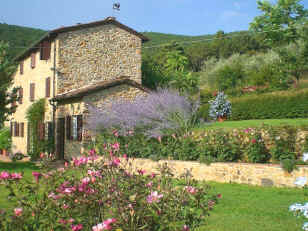The expression Tuscan
villa (and hence Tuscan villa
vacation rentals) alludes not simply to a patrician house but to a house set in a garden and a wider landscape
- a concept derived from the villas of Augustan
Rome via the Renaissance. The ever-adaptable Florentines, as well as the
Anglo-Florentines who settled in Tuscany in significant numbers during
the late 19 C, surrendered to the fad for "English" gardens, with lawns and flowers and plantations of exotic trees. In
Italian Gardens and
Villas, published in 1904, Edith Wharton lamented that "there is perhaps no region in Italy so rich in villas and so lacking in old gardens as the
neighbourhood of Florence." In fact, the Neoclassical garden, which had been considered indispensable through the
17 C and 18 C, was quite "independent of floriculture," as Wharton wrote, its three constituent elements being "marble, water, and perennial verdure." The garden was meant to
harmonise both with the fully man-made world of the villa behind it and with the natural world of the podere, or farm, beyond.
In the time since Wharton wrote, the wheel of fashion has turned and a
great many Renaissance gardens have been restored, to the extent that
finding a giardino all'inglese surrounding a Tuscan villa is now
a rare experience. For most visitors to Tuscany, experiencing a Tuscan villa involves a visit to one of the magnificent Medicean villas in the vicinity of Florence and in the native territory of the Medici, the Mugello (Villa Medicea di Cafaggiolo and Villa Demidoff). Tuscan villa vacation rentals are usually not true villas at all, but rather stand-alone Tuscan farm houses (case coloniche) suitable for a single family or a group of up to something like eight people. Usefully, current fashion dictates that most case coloniche have external walls in unplastered stone while villas are plastered and painted pale brown or apricot in colour. Tuscan villas are also often characterised by a small tower, turret or dovecote (colombaia) set into the roof. Nevertheless, there are Tuscan villas in the original sense available to holiday makers. |

